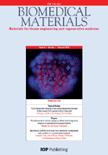
VIEW
Scope & Guideline
Illuminating Pathways in Biomaterials Research and Application.
Introduction
Aims and Scopes
- Biomolecular Imaging Techniques:
The journal highlights advancements in imaging technologies such as optical, photoacoustic, and nuclear medicine imaging, which are pivotal in diagnosing and understanding various diseases. - Nanotechnology and Nanomedicine:
A core focus on the application of nanotechnology in medicine, including drug delivery systems, biosensors, and theranostic platforms that enhance treatment efficacy and diagnostic accuracy. - Artificial Intelligence in Biomedical Research:
Incorporating AI and machine learning approaches to improve diagnostic processes, predict treatment outcomes, and analyze complex biological data is a significant theme in the journal. - Extracellular Vesicles and Cell Communication:
Research on exosomes and other extracellular vesicles is emphasized, particularly their roles in intercellular communication and potential therapeutic applications in various diseases. - Microfluidics and Point-of-Care Diagnostics:
The journal covers innovations in microfluidic devices for rapid diagnostics and biomarker detection, facilitating timely clinical decision-making. - Tissue Engineering and Regenerative Medicine:
Exploration of biomaterials and scaffolds for tissue regeneration and engineering, focusing on the integration of biological and synthetic materials.
Trending and Emerging
- Integration of AI and Machine Learning in Diagnostics:
There is a growing trend towards utilizing AI and machine learning to enhance diagnostic accuracy, particularly in imaging and biomarker identification. - Advancements in Non-invasive Imaging Techniques:
Recent publications emphasize the development of non-invasive imaging modalities, including enhanced fluorescence and photoacoustic imaging, which are crucial for real-time monitoring of diseases. - Focus on Personalized Medicine:
Research on personalized therapeutic strategies, particularly in cancer treatment, is gaining traction, highlighting the importance of tailored approaches based on individual patient profiles. - Development of Smart Biomaterials:
Emerging interest in smart biomaterials that respond to biological stimuli for therapeutic applications is evident, showcasing innovation in tissue engineering and drug delivery. - Exploration of Microbiome Interactions:
An increased focus on the role of the microbiome in health and disease is emerging, particularly its interactions with cancer and immune responses.
Declining or Waning
- Traditional Drug Development Approaches:
There has been a noticeable reduction in publications focusing on conventional pharmaceutical approaches, likely due to the rising interest in personalized medicine and nanotechnology. - Invasive Diagnostic Techniques:
Papers related to invasive diagnostic methods are becoming less frequent, as non-invasive techniques gain prominence due to their patient-friendly nature and technological advancements. - Basic Research without Clinical Application:
Research that does not translate into clinical applications or therapies is waning, as the journal increasingly favors studies with direct implications for patient care.
Similar Journals

BIOMEDICAL MICRODEVICES
Transforming Biomedical Engineering with Micro-InnovationsBIOMEDICAL MICRODEVICES is a leading journal published by Springer that focuses on the innovative field of microdevices within biomedical engineering. With an ISSN of 1387-2176 and an E-ISSN of 1572-8781, BIOMEDICAL MICRODEVICES offers a prestigious platform for researchers to disseminate their findings from 1998 to 2024, demonstrating a long-standing commitment to advancing knowledge in this critical area. The journal is recognized for its significant contributions, boasting a Q2 ranking in Biomedical Engineering and Nanoscience and Nanotechnology, and a Q3 rank in Molecular Biology. Renowned for its rigorous peer-review process, it is positioned within the top 30% of its field according to Scopus rankings, making it a valuable resource for researchers and practitioners alike. Though it operates under a subscription model, the emphasis on quality and relevance within its scope ensures that BIOMEDICAL MICRODEVICES remains a vital source of cutting-edge research that bridges engineering and biological systems, fostering innovation and collaboration in the pursuit of novel health solutions.

Tissue Engineering and Regenerative Medicine
Exploring the Intersection of Engineering and MedicineTissue Engineering and Regenerative Medicine, published by the Korean Tissue Engineering Regenerative Medicine Society, is a distinguished journal focusing on the interdisciplinary fields of tissue engineering, regenerative medicine, and related biomedical innovations. With an ISSN of 1738-2696 and an E-ISSN of 2212-5469, this journal disseminates cutting-edge research and advancements pivotal to developing therapeutic strategies that improve tissue function and repair. As a testament to its scholarly impact, it holds a Q2 ranking in both Biomedical Engineering and Medicine (miscellaneous) categories, reflecting its influence and relevance within the scientific community, particularly with a Scopus rank placing it in the 82nd percentile among similar journals. Although the journal does not offer open access, it provides vital insights and knowledge to researchers, professionals, and students involved in the quest for innovative solutions in medical science and engineering. With its convergence years extending from 2008 to 2024, the journal continues to be an essential platform for the dissemination of high-quality research that drives the field forward.

Annual Review of Biomedical Engineering
Pioneering Discoveries for a Healthier TomorrowAnnual Review of Biomedical Engineering, published by Annual Reviews, stands as a leading academic journal dedicated to the rapidly evolving field of biomedical engineering. With an impressive impact factor that reflects its high citation rates and rigorous peer-review process, this journal offers critical insights by synthesizing cutting-edge advancements and applications in both biomedical engineering and miscellaneous medicine. The journal, which is available in both print (ISSN: 1523-9829) and electronic formats (E-ISSN: 1545-4274), serves as an essential resource for researchers, professionals, and students aiming to stay abreast of significant developments and emerging trends. As of 2023, it is recognized in the top tier (Q1) for both Biomedical Engineering and Medicine, showcasing its esteemed position within the academic community, reflected in its high Scopus rankings. Spanning from 1999 to 2024, the Annual Review of Biomedical Engineering continues to catalyze interdisciplinary collaboration and innovation at the intersection of engineering and healthcare.

JOURNAL OF MATERIALS SCIENCE-MATERIALS IN MEDICINE
Pioneering Discoveries in Biomedical Materials ScienceJOURNAL OF MATERIALS SCIENCE-MATERIALS IN MEDICINE is a leading peer-reviewed journal published by Springer, dedicated to advancing the field of biomedical materials science. With an ISSN of 0957-4530 and E-ISSN 1573-4838, this Open Access journal has been committed to providing researchers and professionals with freely accessible, high-quality research since 2021. It features an extensive scope spanning bioengineering, biomaterials, biomedical engineering, and biophysics, reflecting its significant impact within these interdisciplinary domains. Recognized within the Q2 category of the 2023 rankings in multiple fields, the journal proudly positions itself as a crucial resource for innovative materials that contribute to advancements in medical applications. With impressive Scopus rankings, including 26th in Biophysics and 40th in Materials Science for Biomaterials, researchers, students, and industry professionals alike can rely on this publication for cutting-edge insights that drive the future of medical materials and technologies. Based in Dordrecht, Netherlands, the journal provides a vibrant platform for sharing groundbreaking discoveries and fostering collaborative research among a global audience.

Frontiers in Bioengineering and Biotechnology
Fostering Collaboration to Shape Tomorrow's TechnologiesFrontiers in Bioengineering and Biotechnology, published by FRONTIERS MEDIA SA in Switzerland, stands as a leading platform for innovative research and developments in the fields of bioengineering and biotechnology. Since its inception in 2013, this Open Access journal has garnered significant recognition, reflected in its impressive category rankings: Q1 in Biomedical Engineering and Q2 in Bioengineering, Biotechnology, and Histology for 2023. With a focus on fostering collaboration and knowledge sharing, it aims to provide researchers, professionals, and students with access to pioneering studies that push the boundaries of science and technology. The journal, which is indexed in prominent databases, boasts high visibility and impact, evidenced by its impressive rankings across various categories in Scopus. As it continues to converge from 2013 to 2024, Frontiers in Bioengineering and Biotechnology is dedicated to shaping the discourse in its field and promoting advancements that have the potential to transform healthcare and environmental sustainability.

ACS Biomaterials Science & Engineering
Exploring the Boundaries of Biomaterials ResearchACS Biomaterials Science & Engineering, published by the American Chemical Society, serves as a premier platform for the latest advancements and research in the fields of biomaterials and biomedical engineering. With an impressive impact factor and a strong reputation reflected in its ranking—Q2 in Biomaterials and Q1 in Biomedical Engineering—the journal attracts a diverse and engaged readership. Since its inception in 2015, it has aimed to foster innovation by publishing high-quality research articles, reviews, and perspectives on the synthesis, characterization, and application of biomaterials. Researchers and professionals benefit from the journal's rigorous peer-review process and its focus on translational science, making it essential for those looking to stay at the forefront of biomaterials research. Located in Washington, DC, USA, the journal plays a pivotal role in connecting academic and industrial sectors, ultimately driving advancements that impact biomedicine and related fields.

Advanced NanoBiomed Research
Transforming Ideas into Biomedical SolutionsAdvanced NanoBiomed Research is a pioneering open-access journal committed to advancing the interdisciplinary field of nanobiotechnology, published by WILEY-V C H VERLAG GMBH. Since its inception in 2021, this journal has provided a platform for innovative research that bridges the gap between engineering, medicine, and materials science. With impressive rankings in Scopus, positioning it within the top quartiles of various categories, Advanced NanoBiomed Research aims to disseminate high-quality research that contributes to the understanding and application of nanomaterials in biomedical contexts. As it encompasses a wide scope—from applied microbiology to biomaterials—it serves as an essential resource for researchers, professionals, and students eager to explore the cutting-edge developments in the field. The journal promotes a collaborative environment where emerging ideas can flourish, ensuring that vital advancements in nanobiomedicine can be shared and built upon within the scientific community.

Biomedical Materials
Transforming Science into Life-Saving Solutions.Biomedical Materials, published by IOP Publishing Ltd, is a premier journal dedicated to the rapidly evolving field of biomedical engineering and materials science. With a robust impact factor showcasing its influence, this journal serves as a vital platform for disseminating pioneering research from 2006 to 2024. Covering an array of interdisciplinary topics—ranging from biomaterials to bioengineering and applied chemistry—the journal consistently ranks in the second quartile across multiple categories including Bioengineering (Q2), Biomaterials (Q2), and Biomedical Engineering (Q2) as of 2023. Researchers, professionals, and students alike benefit from its contributions, exploring innovative solutions at the intersection of biology and material science. Although not an Open Access journal, Biomedical Materials remains essential in advancing our understanding and facilitating discussions surrounding state-of-the-art materials that revolutionize medical applications and enhance patient care.

International Journal of Nanomedicine
Transforming research into revolutionary healthcare solutions.International Journal of Nanomedicine, published by DOVE MEDICAL PRESS LTD, is a leading open access journal dedicated to advancing the field of nanomedicine and its applications in healthcare. Since its establishment in 2006, the journal has grown significantly, now encompassing a wide array of topics including bioengineering, biomaterials, biophysics, drug discovery, and pharmaceutical sciences, and is recognized in Q1 quartiles across major categories like *Nanoscience and Nanotechnology* and *Organic Chemistry*. The journal boasts an impressive standing within the Scopus rankings, with high percentiles across various related fields, making it an invaluable resource for researchers, professionals, and students seeking to stay informed on the latest innovations and developments in nanomedicine. With its commitment to fostering an accessible and collaborative academic environment, the International Journal of Nanomedicine serves as a vital platform for disseminating transformative research that impacts scientific practice and healthcare outcomes globally.

Biomaterials Research
Transforming research into real-world applications.Biomaterials Research, published by the American Association for the Advancement of Science, is a prominent open access journal established in 2014, dedicated to advancing the field of biomaterials. Based in the United Kingdom, this journal has swiftly become an essential platform for researchers and practitioners, offering groundbreaking insights in biomaterials, biomedical engineering, ceramics and composites, and miscellaneous medical fields. With its impressive Q1 ranking across multiple relevant categories in 2023 and its strong Scopus rankings, including a remarkable 90th percentile in the medicine category, Biomaterials Research showcases high-quality, peer-reviewed research designed to address both practical and theoretical challenges in biomaterials science. As an open access journal, it promotes wider dissemination and accessibility of research findings, crucial for fostering innovation and collaboration within the scientific community. Researchers, professionals, and students alike are encouraged to contribute, read, and engage with the latest developments in this dynamic field.